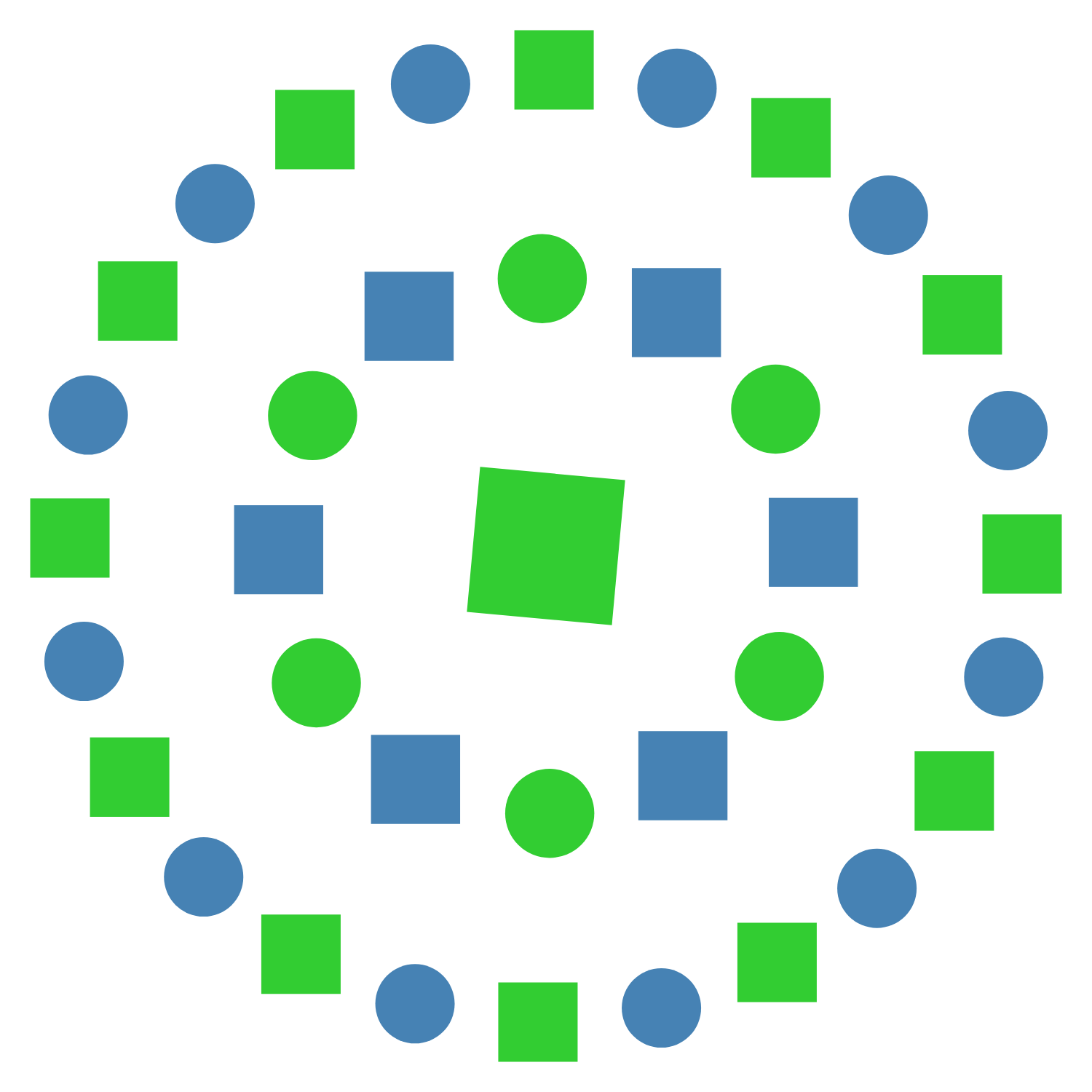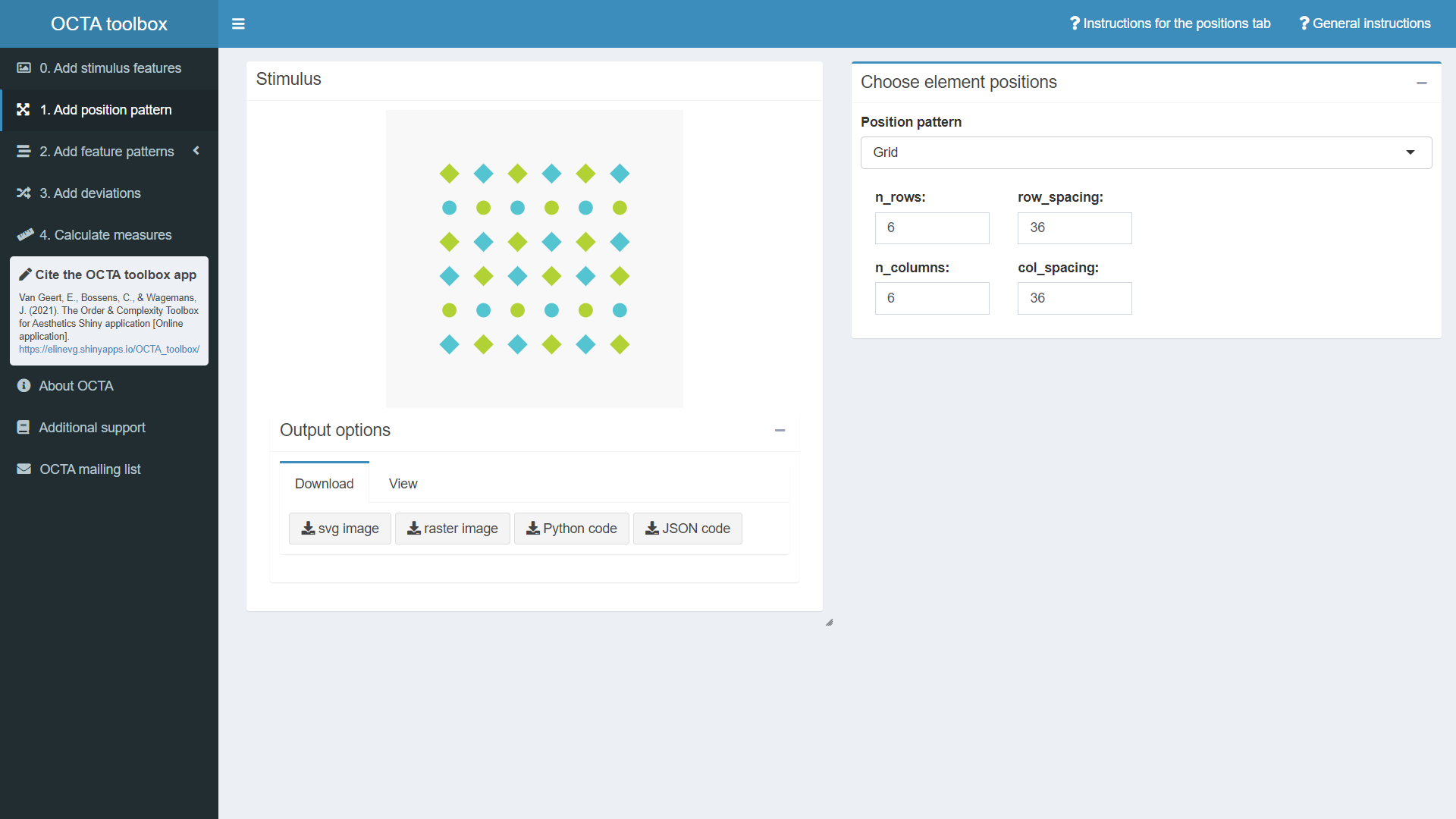The OCTA Toolbox: A new tool to create flexible andreproducible stimuli for studying perception and appreciation
Eline Van Geert, Christophe Bossens, & Johan WagemansLaboratory of Experimental Psychology, KU Leuven, Belgium
Aim of OCTA
Create reproducible and flexible multi-element displays varying qualitatively and quantitatively in:
ORDER  structure and organization
structure and organization
COMPLEXITY  quantity and variety
quantity and variety
available as a free tool for programmers (as a Python library) and non-programmers (as an online Shiny app)
Test the OCTA Shiny app & code
1 Create stimulus
Stimulus types
Stimulus features ➜
- Grid
- Outline
- Concentric
2 Add element positions
Position pattern definitions
3 Add feature patterns & values
Features (including dynamic feature options!)
 shapes
shapes
 fillcolors
fillcolors
 boundingboxes
boundingboxes
 orientations
orientations
 borderwidths
borderwidths
 bordercolors
bordercolors
 opacities
opacities
 mirrorvalues
mirrorvalues
additional non-visual features: links, classlabels, idlabels
Pattern types
 Repeat
Repeat
 ElementRepeat
ElementRepeat
 Mirror
Mirror
 Gradient
Gradient
 Random
Random
 TiledGrid
TiledGrid
 TiledElementGrid
TiledElementGrid
Pattern directions
 AcrossElements
AcrossElements
 AcrossRows
AcrossRows
 AcrossColumns
AcrossColumns
 AcrossLeftDiagonal
AcrossLeftDiagonal
 AcrossRightDiagonal
AcrossRightDiagonal
 AcrossLayers
AcrossLayers
4 Add deviations & calculate measures
Position and element deviations
 position jitter
position jitter
 position deviations
position deviations
 swap elements
swap elements
 randomize elements
randomize elements
 remove elements
remove elements
Feature deviations
 swap features
swap features
 change features
change features
 randomize features
randomize features
 jitter features
jitter features
Calculate order and complexity measures
Calculate your own measures using the vector or raster image output
ORDER pattern type congruency pattern direction congruency # pattern deviants # position deviants
COMPLEXITY # elements # distinct elements # distinct values # non-identical features
5 Render, save, and recreate the stimulus
Output options
 SVG
SVG
 PNG scale 0.5
PNG scale 0.5
 PNG scale 1
PNG scale 1
 PNG scale 10
PNG scale 10
- stimulus as vector image (SVG)
- stimulus as raster image (PNG, JPG, PDF, TIFF)
- computer-readable JSON output to recreate the stimulusin Python with the LoadFromJSON function
- in the online Shiny app: download or view the Python codeto create the stimulus in Python
Set a seed to reproduce the exact same random deviations
Scale option to increase quality for raster images
 PNG scale 0.5
PNG scale 0.5
 PNG scale 1
PNG scale 1
 PNG scale 10
PNG scale 10
Applications
Why use OCTA?
- varying qualitatively or quantitatively in order and/or complexity
- reproducible, adjustable, and open source
- easy to create
- tailored for online use
- static or dynamic
- multimodal (adding sound is possible using Javascript)
- …
Contact
Eline Van Geert - eline.vangeert@kuleuven.be
supported by a Ph.D. fellowship of the Research Foundation - Flanders (FWO)
supported by a Ph.D. fellowship of the Research Foundation - Flanders (FWO)

European Conference on Visual Perception 2021 - August 26th - Virtual
